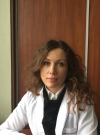
Contributions
Abstract: PB1904
Type: Publication Only
Background
Leukemic stem cells (LSCs) and myeloid progenitor cells are believed to play an important role in the pathogenesis of chronic myeloid leukemia (CML). LSCs are able to remain at hemopoietic niches for a long time, remaining insensitive to TKI. It is very difficult to identify using cytogenetic and molecular diagnostic methods. Therefore, in a long-term remission, after the discontinuation of the TKI therapy, LSCs can cause relapse of CML in patients’ bone marrow.
Aims
The aim of our study is to compare the proliferative activity of hemopoietic stem and progenitor cells of patients with CML who had a long-term remission as a result of TKI treatment.
Methods
We studied bone marrow samples of 17 patients with CML who had a long-term remission as a result of the TKI therapy. Experiments were conducted in vitro, with a use of liquid culture. In order to accumulate the bone marrow stem cells, patients’ hemopoetic cells were cultivated for 28 days with bone marrow stromal cells in DMEM culture medium (SIGMA, USA) with addition of 10% fetal calf serum (SIGMA, USA). Subsequently, patients’ hemopoietic stem cells were cultivated in a liquid culture in vitro in RPMI medium (SIGMA, USA) with an addition of a granulocyte-macrophage colony stimulating factor (SIGMA, USA) and a 20% fetal calf serum. We counted the number of cells in the liquid culture using a Goriaev’s chamber. We also prepared hematopoietic cell samples after cultivation, using cytocentrifuge. We stained samples using Pappenheim method and counted different hemopoetic cells under a microscope. We compared the results of cultivation with the presence of CML remission in patients after 6 months of discontinuation of TKI.
Results
After cultivation of patient’s bone marrow cells in a liquid culture in vitro solely with bone marrow stromal cells, there was a small number of hematopoietic precursor cells (15-37,000 per ml) on 28th day of cultivation. Following the cultivation, these cells were removed and cultivated with an addition of the granulocyte-macrophage colony stimulating factor. The results showed that in patients who had CML relapse six months after the discontinuation of the TKI therapy, the proliferative activity of hemopoietic progenitor cells increased by 17%, compared to Patients who had a stable remission as a result of a TKI therapy. In addition, patients’ with unstable remission as a result of TKI therapy showed the prevalence of early forms of cells of the granulocyte-macrophage series (blast cells, promyelocytes and myelocytes).
Conclusion
Consequently, long-term cultivation with stromal cells allows to accumulate the stem cells and the early progenitor bone marrow cells from patients with CML. LSCs seem to be the reason of CML relapses when the TKI therapy is discontinued. They remain in a state of rest for a long time, and are able to restore the leukemia clone under favorable conditions.
Session topic: 7. Chronic myeloid leukemia – Biology & Translational Research
Keyword(s): Chronic myeloid leukemia, Leukemic Stem Cell, Treatment
Abstract: PB1904
Type: Publication Only
Background
Leukemic stem cells (LSCs) and myeloid progenitor cells are believed to play an important role in the pathogenesis of chronic myeloid leukemia (CML). LSCs are able to remain at hemopoietic niches for a long time, remaining insensitive to TKI. It is very difficult to identify using cytogenetic and molecular diagnostic methods. Therefore, in a long-term remission, after the discontinuation of the TKI therapy, LSCs can cause relapse of CML in patients’ bone marrow.
Aims
The aim of our study is to compare the proliferative activity of hemopoietic stem and progenitor cells of patients with CML who had a long-term remission as a result of TKI treatment.
Methods
We studied bone marrow samples of 17 patients with CML who had a long-term remission as a result of the TKI therapy. Experiments were conducted in vitro, with a use of liquid culture. In order to accumulate the bone marrow stem cells, patients’ hemopoetic cells were cultivated for 28 days with bone marrow stromal cells in DMEM culture medium (SIGMA, USA) with addition of 10% fetal calf serum (SIGMA, USA). Subsequently, patients’ hemopoietic stem cells were cultivated in a liquid culture in vitro in RPMI medium (SIGMA, USA) with an addition of a granulocyte-macrophage colony stimulating factor (SIGMA, USA) and a 20% fetal calf serum. We counted the number of cells in the liquid culture using a Goriaev’s chamber. We also prepared hematopoietic cell samples after cultivation, using cytocentrifuge. We stained samples using Pappenheim method and counted different hemopoetic cells under a microscope. We compared the results of cultivation with the presence of CML remission in patients after 6 months of discontinuation of TKI.
Results
After cultivation of patient’s bone marrow cells in a liquid culture in vitro solely with bone marrow stromal cells, there was a small number of hematopoietic precursor cells (15-37,000 per ml) on 28th day of cultivation. Following the cultivation, these cells were removed and cultivated with an addition of the granulocyte-macrophage colony stimulating factor. The results showed that in patients who had CML relapse six months after the discontinuation of the TKI therapy, the proliferative activity of hemopoietic progenitor cells increased by 17%, compared to Patients who had a stable remission as a result of a TKI therapy. In addition, patients’ with unstable remission as a result of TKI therapy showed the prevalence of early forms of cells of the granulocyte-macrophage series (blast cells, promyelocytes and myelocytes).
Conclusion
Consequently, long-term cultivation with stromal cells allows to accumulate the stem cells and the early progenitor bone marrow cells from patients with CML. LSCs seem to be the reason of CML relapses when the TKI therapy is discontinued. They remain in a state of rest for a long time, and are able to restore the leukemia clone under favorable conditions.
Session topic: 7. Chronic myeloid leukemia – Biology & Translational Research
Keyword(s): Chronic myeloid leukemia, Leukemic Stem Cell, Treatment


